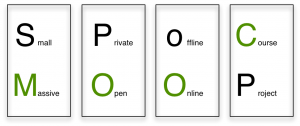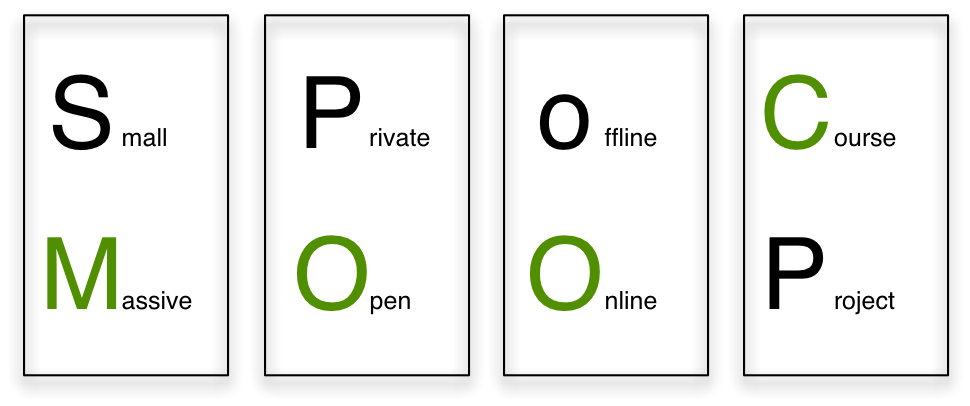MOOCs are offering a new outlook on education. They’ve changed several traditional parameters: small has become Massive, closed has become Open, and offline has become Online. But the final traditional element, and perhaps the most important, has not changed. What would happen if we turned courses into Projects? What would a MOOP look like and what would if offer?
While MOOCs have altered quite a few traditional structures of formal education, they still cling to one.
Course (noun): a series of lectures or lessons in a particular subject, leading to an examination or qualification

Sound familiar? Yep. Even if MOOCs are opening up previously closed university doors, democratizing education, and making it all accessible from the comfort of your home or commute route, you’re still served courses. Courses have lessons, a subject, and an examination. Let’s take a look at each of those in turn.
Examinations
If we’re to look at modern educational research, we see that examinations are not very beneficial in learning. They encourage cramming, which clearly has no long-term benefits. Granted, they are an easy method of administering a (partially invalid and simplified) check on learner achievement, but that seems to be their only benefit: they are easy to administer. The disadvantages outweigh the advantages: they steer learning efforts towards surface learning, memorization, and the specific topics that the exam will cover.
More involved methods of assuring student attainment are peer and group evaluations, portfolios and project work (possibly with real customers). They take more effort, and may be less systematic, but do provide a richer insight into what the learners have in fact mastered.
I’m not the only one thinking like this. Read the section on the disadvantages and criticism on standardized test on Wikipedia.
Subjects
A topic is quite handy have so you know the knowledge or skills you’re going to get from the learning opportunity. But by limiting the range of inquiry during a learning session to a single subject area, we’re forced to consider the subject as a mandatory piece of information that everything needs to be labeled under. Indeed, if the goal is to allow learners to truly understand something and to be able to apply what they’ve learned across disciplines, it behooves us to offer multiple viewpoints to a theme. Approaches like phenomenon-based pedagogy try to lift these strict boundaries and allow learners to look at a phenomenon from all angles, irrespective of the course’s subject area.
Example: One could study migratory bird routes in biology class. Or one could look at the phenomena of climate change, and study how it affects migratory birds, different biota, global agricultural patterns, future economics, and so on. One can easily argue that the latter approach will give more insights and background understanding about animal migrations (and even human migrations) that just learning about migratory bird routes in isolation.
From the teachers’ point-of-view, thinking along the lines of subject areas is also damaging. Most western primary education follows a strikingly similar selection of subject areas; things like mathematics, geography, arts, language, physics, and so on. Ever think about where that list comes from? And what it’s based on? And how it affects education?
The main problem is that thinking along the lines of subject areas will create artificial walled gardens. “Only physics teachers may discuss how to teach physics.” It is obvious that most modern pedagogical approaches are subject-area agnostic, yet the communities of teaching professional cling to these fabricated divisions between subject areas in all of education, from primary school to higher education.
Meanwhile in Finland, schools are moving from subject areas to phenomenon-based learning topics.
Lessons
Ah yes, what better way to impart knowledge than to gather all the learners into the same room, and have someone with expert knowledge orate his knowledge? Well, possibly in the dark Middle Ages when information was near-impossible to transfer in any other format than speech.
Lessons have evolved, of course. Lessons of good teachers are interactive, individualized, and engaging. But still, having 45 minute or 75 minute (or whatever) length segments where you concentrate on a single subject area, and then switch to something completely different, seems quite alien from workplaces. Well, possibly workplace meetings are quite similar, but we all know how adults behave in pointless meetings. There’s no reason to expect teenagers to behave any better in situations where it’s hard to see the point of spending time on something just because it’s in the schedule.
Projects get rid of exams, subjects, and lessons
Project-based learning is nothing new, of course. Teachers and schools have been implementing such practices for all of history. Think of apprenticeships in the middle ages: projects, small and large. Theory and routine drills come into play when they are needed. Look at university level medical studies in most countries: problem-based learning with projects.
While it’s of course hard to exactly ensure that all students get the decreed amount of math and arts and all that into their personal curricula when it’s filled with projects, I’d argue that that is irrelevant. It is obvious that even young students will focus on some topics more, and mainly ignore others. Specialization happens at an early age. Why force-feed everyone with the same amount of all subject areas, when clearly their interests differ?
Project-based learning will ensure that students will be exposed to all subject areas (and can become interested and delve deeper if they wish to), have meaningful goals for their work, and learn skills that actually matter in the work life. Hmm… let’s qualify that with “good project-based learning”. There are good and bad projects, and we need well run projects that enable, not hinder.
Now, teachers are by no means obsolete. Their even more crucial tasks are to follow each learners’ individual study plans and the path they take towards mastery (of something). It’s called coaching, not lecturing. It can be called teaching as well. Certainly it’s education.
Some thoughts on freedom and engagement
Freedom and control are of course key concepts in managing a group of students. And there’s no simple answer to this. The balance between freedom and control will shift as the students become more responsible for their own learning. This increases with age, but also varies based on motivation and engagement.
Motivation is the tension between subject and object. How to help create that tension between a student and a topic of inquiry? Extrinsic motivators are things like mandatory attendance, dictating tasks to students, monitoring their compliance, and punishing violations. Extrinsic motivators could also be rewards for outstanding performance, social praise, and peer pressure. The problem with all extrinsic motivation is that the topic of inquiry itself is not a motivator. This steers the focus of the student from the topic to the motivational structures.
Intrinsic motivation happens when the student wants to work on the topic without any external reasons. The road from full extrinsic motivation to full intrinsic motivation goes through stages. And of course, if you start with eager first-graders, they’re already intrinsically motivated. Just make sure not to squish that motivation! But if you start with amotivated students, these are the stages:
- External regulation and external motivation
- Introjection, where the student projects values and views from other people to themselves
- Identification, where the student gains ownership of the motivator and starts valuing it
- Integration, where the student’s internal goals are aligned with the extrinsic motivator
These steps seem a bit abstract. But there are many practical common-sense tips on getting students self-motivated. Take into account their existing interests and embed them into the activities. Show that their work has meaning beyond short-term. Give them a suitable challenge, not too much and not too little. Give them frequent feedback. Allow and encourage experimentation and failure. And so on. These are actually just simple guidelines from the realm of engagement design (also known as gamification).
Now, if your students are really not motivated, giving them a project and free reigns to decide how they’ll proceed may not lead to a good outcome. Building in external motivational elements makes sense. The exact level and strictness needed depends on the case, but if they start limiting the freedoms very much, the project work turns into an extended series of exercises.
In the realm of online education, we can name the opposites. A Learning Management System (LMS) is often the strict, controlled environment, where each step of the students is monitored and evaluated. On the other end of the spectrum, is the Personal Learning Environment (PLE), which is basically just the ever-changing collection of tools, materials, people, and other elements that an individual student uses in their learning.
An xMOOC is somewhere in between an LMS and a PLE, although closer to an LMS. A cMOOC would typically be closer to a PLE.
MOOP
So, let’s take projects and turn them massive, open and online. What could they be? One MOOP comes to mind immediately: Wikipedia. It’s massive, open, online, and a project (although a never-ending one). In Finland I’ve seen several phenomenon-based learning projects involving several schools across the country. Flat Connections (previously the Flat Classroom Project) has been doing this for years in global scale.

And certainly we shouldn’t now be stuck with the M, O, O components. There’s value in considering, whether a small (instead of massive), or closed (instead of open) makes more sense in a given situation. What I’d like to see is that we can switch all of these elements on or off and create a learning scenario that fits each need.
I do not have final answers on how to implement a MOOP as part of an official educational institution’s course offerings. I have some ideas, though. Let’s discuss.

Thanks for this post Tarmo, I think Finnish educators should write more in English.
You handled the ideas of good working pedagogies in which you believe just now. I think you should change the heading because you don’t speak about MOOCs generally. There are many different possibilities inside MOOCs. I am one of those people who use everything as a part of my personal learning and there are hundreds/thousands of us. As you know. So please change the heading before translating this into Finnish (they asked it in FB a minute ago)